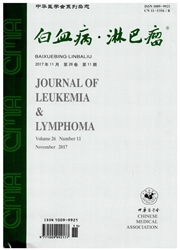

 中文摘要:
中文摘要:
目的探索采用增强预处理强度的异基因造血干细胞移植(allo—HSCT)联合快速递减免疫抑制剂和供者淋巴细胞输注(DLI)策略治疗母细胞性浆细胞样树突状细胞肿瘤(BPDCN)的效果。方法2009年7月至2011年5月,南方医院血液科确诊2例BPDCN,例1患者以皮肤浸润起病,经皮肤病理活组织检查确诊CDICD;6LCA+TdT CD;3BPDCN侵犯皮下及真皮层,移植前经联合化疗处于完全缓解;例2患者以骨髓浸润起病,先后误诊为急性淋巴细胞白血病和急性非淋巴细胞白血病,后经流式细胞术免疫分型诊断CDICD;6CD。南BDCA-1 BPDCN,移植前未缓解。接受以全身放疗联合环磷酰胺为基础的增强预处理a110—HSCT,供者均来源于同胞;采用环孢素A(CsA)联合短疗程甲氨蝶呤(MTX)预防移植物抗宿主病(GVHD),单倍体相合移植加用兔抗人类胸腺细胞免疫球蛋白(ATG);移植后2个月开始快速减停免疫抑制剂,采用流式细胞术监测微小残留病(MRD)指导或采用预防性DLI防治复发。结果移植后2例患者均获完全供者植入及完全缓解,其中例1处于持续缓解,+6个月行DLI诱发Iv度皮肤及肠道急性GVHD,经联合免疫抑制治疗后控制,+243天死于血栓性微血管病、弥漫性肺泡出血;例2患者+60天复发,经化疗联合DLI、白细胞介素.2治疗后未缓解,+101天死于败血症、弥漫性血管内凝血。结论BPDCN以CD4CD56CD123 CD4;Tdr树突状细胞来源的肿瘤细胞浸润皮肤和(或)骨髓、临床进程呈高度侵袭为典型特征,增强预处理的allo+HSCT联合快速递减免疫抑制剂和MRD监测指导DLI对早期BPDCN可有效控制疾病发展,但对于难治复发患者仍需更多研究。
 英文摘要:
英文摘要:
Objective To investigate the effect of allogeneic hematopoietic stem cell transplantation (allo-HSCT) with intensified conditioning regimen followed by rapidly tapering immunosuppressants and sequential minimal residual disease (MRD)-guided donor lymphocyte infusion (DLI) post-transplantation on outcome of blastic plasmacytoid dendritic cell neoplasm (BPDCN). Methods Two cases of BPDCN from January 2009 to May 2011 in Nanfang hospital were diagnosed according to 2008 WHO classification of tumours of haematopoietic and lymphoid tissues. Case 1 initially presented with typical cutaneous involvement and was promptly diagnosed with CD~ CD~ LCA~ TdT+ CD~ BPDCN by skin biopsy. Case 2 was recognized as acute lymphocyte leukemia and acute non-lymphocytic leukemia, which was diagnosed to BPDCN at recurrence through flow cytometry analysis. Total-body-irradiation plus cyclophosphamide based intensified conditioning regimen were followed by allo-HSCT from sibling donor. Graft-versus-host disease (GVHD) prophylaxis consisted of cyclosporine and methotrexate. Anti-thymocyteglobulin was included additionally for haploid donor allo-HSCT. Multi-color labeling flow cytometry was performed to monitor MRD. Rapidly tapering of prophylactic immunosuppressants and sequential MRD-guided donor lymphocyte infusion (DLI) were performed to control relapse of primary malignancy. Results Two cases of BPDCN received allo-HSCT from sibling donor after intensified conditioning regimen. Both patients achieved complete remission and complete donor engraftment. Case 1 survived refractory acyclovir-resistant Epstein-Barr virus viremia benefiting from preemptive treatment with rituximab and DLI-induced grade 1V acute GVHD, but died of thrombotic" mieroangiopathy mixed with diffuse alveolar hemorrhage and sepsis on +243 days. Case 2 relapsed just 2 months after allo-HSCT despite DLI and rapidly tapering of CsA, died of sepsis followed by diffuse intravaseular coagulation on +101 days. Conclusion BPDCN is characterized
 同期刊论文项目
同期刊论文项目
 同项目期刊论文
同项目期刊论文
 期刊信息
期刊信息
